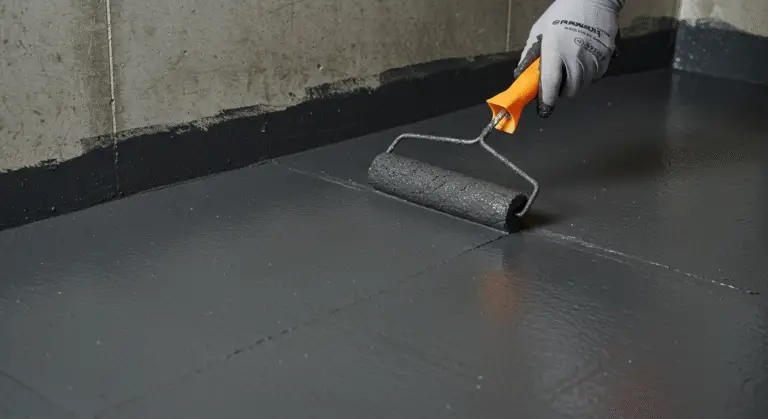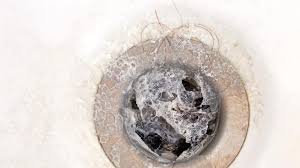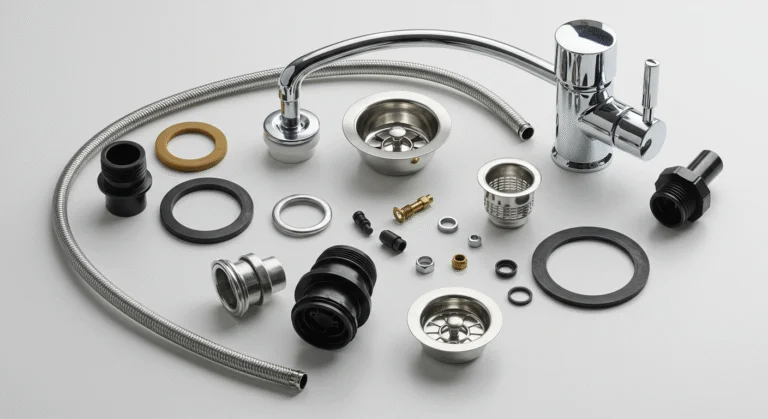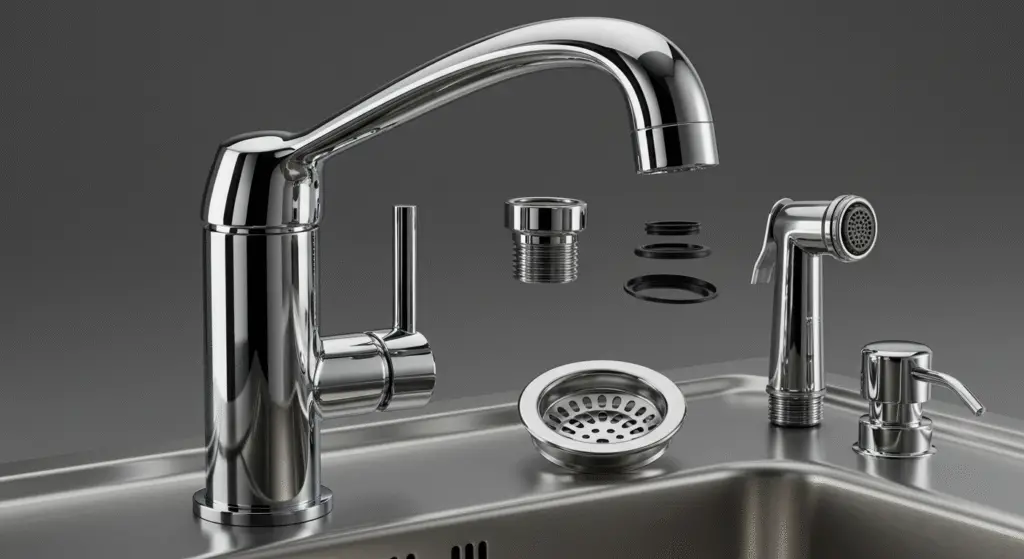
Understanding the parts of a kitchen sink is crucial for anyone who wants to maintain, repair, or upgrade their kitchen setup. While the sink may seem like a simple fixture, it’s made up of several important components, each playing a specific role in how your kitchen functions on a daily basis.
Whether you’re planning a kitchen renovation, replacing a faucet, or trying to fix a leaky pipe, knowing the structure and purpose of each part can save you time, money, and stress. In this guide, we’ll break down everything you need to know about the parts of a kitchen sink and how they work together to provide clean water, efficient drainage, and practical use.
What Are the Main Parts of a Kitchen Sink?
At first glance, a kitchen sink looks like just a bowl with a faucet. However, there are several interconnected parts that make it functional. Each piece, from the faucet to the drain trap, plays a role in water delivery, waste disposal, or structural support.
Let’s explore the most common parts of a kitchen sink and their functions.
Sink Basin
The basin is the main part of the sink—the area where you wash dishes, rinse vegetables, and clean your hands. Sink basins come in single, double, and even triple-bowl configurations depending on your kitchen’s needs. Materials vary and include stainless steel, porcelain, cast iron, granite composite, and more. The size and depth of the basin can affect how much you can clean at once and how comfortable the sink is to use.
Faucet Assembly
The faucet is one of the most visible parts of a kitchen sink, responsible for delivering hot and cold water. Faucets range from basic designs to advanced models with features like pull-out spray heads, filtration systems, and motion sensors. A good faucet should match your sink type, offer good water pressure, and be easy to clean and maintain.
Faucets connect to your home’s plumbing through water supply lines, which are usually hidden below the sink.
Water Supply Lines
These flexible hoses carry hot and cold water from the shut-off valves to the faucet. They’re usually made of braided stainless steel or reinforced rubber. While hidden from view, these lines are critical for reliable water flow. If damaged or worn out, they can cause leaks under the sink.
Shut-Off Valves
Shut-off valves control the flow of water to the faucet and are typically located beneath the sink. Having easy access to these valves is important when performing repairs or replacements. If a faucet is leaking or a water line bursts, you can shut off the water here without turning off the supply to the entire house.
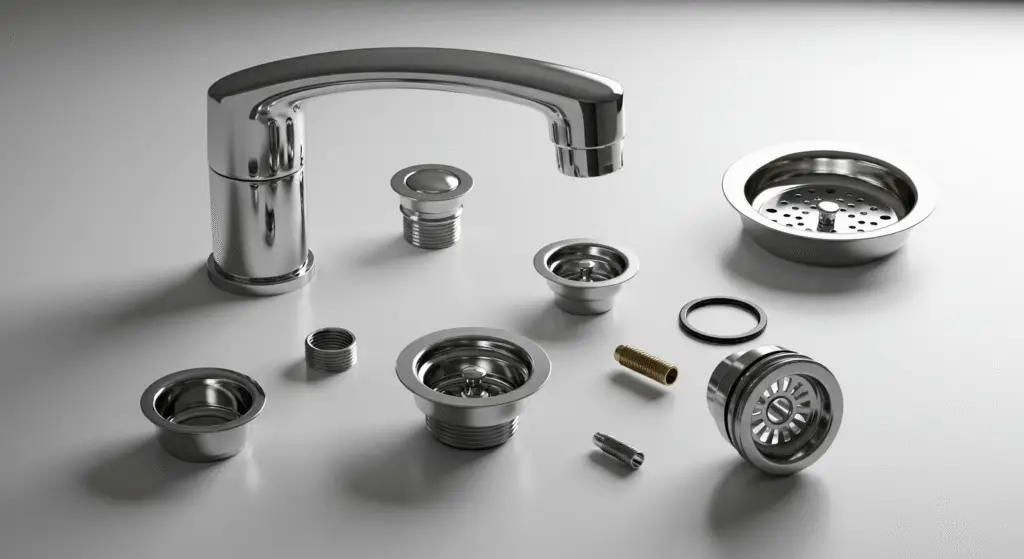
Sink Strainer and Drain Assembly
The sink strainer sits in the drain opening and helps catch food particles, preventing clogs in your plumbing. It’s usually removable, allowing you to clean it out easily. Beneath the strainer is the drain assembly, which includes gaskets, flanges, and locknuts that seal the drain and guide wastewater toward the P-trap.
This part of the sink must be properly sealed to prevent water leaks.
P-Trap
The P-trap is a curved pipe located under the sink. It plays a crucial role in preventing sewer gases from entering your home. It does this by holding a small amount of water that blocks those gases from rising through the drain. Made of PVC or metal, the P-trap is also a common spot for clogs to develop due to food particles or grease buildup.
Garbage Disposal Unit (Optional)
In many modern kitchens, a garbage disposal unit is installed between the sink strainer and the P-trap. This device grinds up food scraps so they can safely pass through the plumbing system. While not a required component, it’s a helpful addition that enhances functionality. Regular maintenance and proper use (like running cold water during operation) will help avoid malfunctions.
Mounting Hardware
Whether your sink is drop-in or under-mount, it’s held in place with mounting clips, brackets, and adhesive sealant. These components are installed underneath the countertop to ensure the sink stays secure and leak-free. Proper installation is critical to avoid gaps or water damage to the surrounding area.
Air Gap (if Applicable)
An air gap is a small fixture that prevents backflow from the drain into your dishwasher. It’s typically mounted on the countertop near the faucet and is a required component in many plumbing codes. While small, it serves an essential health function by preventing contamination of your dishwasher with dirty water.
Why It’s Important to Know the Parts of a Kitchen Sink
Knowing the parts of a kitchen sink gives you the ability to:
- Troubleshoot problems like leaks, clogs, or low water pressure.
- Perform minor repairs or replacements yourself.
- Communicate effectively with plumbers or contractors.
- Make informed decisions during kitchen renovations.
- Avoid costly damage by spotting wear-and-tear early.
Each component has a specific role, and when one fails, it can affect the entire system. Understanding how everything works together allows for better maintenance and improved performance.
Maintenance Tips for Kitchen Sink Parts
To keep all the parts of a kitchen sink working efficiently, follow these basic maintenance tips:
- Clean the sink and strainer regularly to avoid buildup.
- Check for signs of leaks under the sink at least once a month.
- Avoid putting grease, coffee grounds, or fibrous foods in the drain.
- Tighten any loose fittings or connections as soon as they are noticed.
- Replace worn-out supply lines and gaskets promptly.
Routine maintenance helps extend the lifespan of your sink and prevents expensive plumbing issues.
Final Thoughts on the Parts of a Kitchen Sink
The parts of a kitchen sink may not get much attention, but they are essential to the functionality of your kitchen. From delivering clean water to removing waste, every piece works behind the scenes to support your daily routines.
By understanding what these components are and how they work, you gain more control over your kitchen’s maintenance and performance. Whether you’re dealing with a leak, planning a remodel, or simply want to upgrade your faucet, this knowledge empowers you to take action with confidence.
